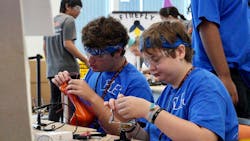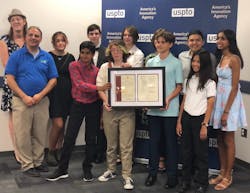So That Happened: Lordstown Motors Bound for Court, General Motors Downgrade, Stihl Hosts Summer Camp
Editor’s note: Welcome to So That Happened, our editors’ takes on things going on in the manufacturing world that deserve some extra attention. This will appear regularly in the Member’s Only section of the site.
When Ransomware Bills Come Due
We know cybercriminals love to hit manufacturers with ransomware attacks. IndustryWeek probably doesn't need to beat you over the head with the point any further, for a while. But how much do all of these ransomware attacks cost manufacturers?
If we're talking about ransoms paid, probably not much. But if we're talking about losses owing to downtime, that may be an entirely different story.
According to a new report from Comparitech that covers the period from 2018 to July 2023, 478 confirmed ransomware attacks were launched on manufacturing companies, with 167 attacks confirmed in 2020 alone. The transportation/automotive sector suffered 92 attacks in that period while the electronics/appliances sector suffered 80.
The average downtime forced by ransomware attacks was 6.4 days in 2021 and 12.2 days in 2022. And the total bill for downtime during the period covered by the report was $46.2 billion. The worst year was 2020, with $14.2 billion in losses.
No country's downtime losses come even close to the United States, with $20.31 billion caused by 212 attacks. The second place winner was Germany, with $5.52 billion flushed by ransomware attackers over 41 attacks. France came in third, losing $3.95 billion owing to 30 ransomware attacks. This data include the caveat that not all nations have the same sort of data breach reporting tools and regulations as in the United States, which obviously could skew the numbers.
According to the report, only four companies confirmed meeting ransomware demands. It's possible that many organizations paid out but didn't report doing so, however, for fear of marking themselves as high-priority targets for future attacks.
Stihl Holds STEM Summer Camp
In partnership with the Virginia Manufacturers Association, power equipment manufacturer Stihl Inc. hosted its ninth Manufacturing Technology Summer Camp. The program hosted 34 high school students at its Virginia Beach manufacturing facility from July 26-29. The free program gives teenagers a look into various aspects of the manufacturing process, such as planning, budgeting, product quality and collaboration. This year’s theme was “Lighting the Future.”
“This program allows us to engage with students and introduce them to a STEM career field and new technologies, with the goal of really getting them passionate about this industry and correcting any old misconceptions they may have about manufacturing,” said Courtney Addison, Stihl Inc. manager of talent development.
The students worked in teams on a hands-on technology-based project to build desk lamps. On the last day of the camp, teams competed before a panel of judges; the members of the winning team received a $1,000 scholarship from Virginia Industry Foundation.
“This camp is a great way to promote local manufacturing and introduce students to careers in a field that they may not otherwise have exposure,” said Lorraine Amesbury Holder, senior vice president of operations at Stihl. “Not only do the students walk away from this camp learning about Stihl Inc., this camp leaves students excited about pursuing careers in manufacturing after they graduate, helping Stihl Inc. and other companies fill their future positions.”
Lordstown Bankruptcy Takes a Detour
The bankrupt Lordstown Motors Corp. is going to go to trial over claims of stolen technology. The company, which filed for Chapter 11 bankruptcy in late June, was accused by Karma Automotive of employee poaching and stealing tech related to vehicle infotainment back in 2020.
The trial is set for September 12 in California, the exact date Lordstown was hoping to conclude its final asset sale hearing under its proposed accelerated timeline (total coincidence, for sure). However, a judge has stopped the company in its tracks, ruling that the outcome of the California trial will determine what exactly Lordstown is even entitled to sell. As of Aug. 4, Lordstown says it has 13 parties interested in buying all or some of its assets, whatever those may be by the end of the litigation.
Karma isn’t the only entity Lordstown seems to be running from, either. Aside from suing Foxconn, whose pulling out of a deal with the company set Lordstown on the path to bankruptcy in the first place, Lordstown is also facing an investigation by the U.S. Securities and Exchange Commission and lawsuits from investors over claims it misled both them and consumers.
No wonder they’re trying to make it someone else’s headache ASAP.
A Yellow Warning Flag?
Independent stock research firm CFRA made some market waves Friday when it downgraded shares of General Motors Corp. to the very rare ‘strong sell’ (from ‘hold’), with analyst Garrett Nelson primarily citing the growing risks of a United Auto Workers strike.
GM’s contract with the UAW expires Sept. 14 and union President Shawn Fain—he of the “Let’s get ready to rumble!” acceptance speech—is pushing hard for major wage gains as well as other benefits. That the sides haven’t said they are making solid progress was a major factor in Nelson cutting his rating of GM’s stock and slashing his price target to $28 from $40, which implies a loss of some $15 billion in market value.
Two things are evident: 1) Organized labor sees today’s economy as one in which it can recover ground lost during and since the Great Recession that started 15 years ago and 2) its chances of doing so are more than decent. The International Brotherhood of Teamsters has in recent months secured upgraded contracts at trucking companies ArcBest Corp. and United Parcel Service Inc., the latter so favorable to workers as to cause its executives to cite higher labor costs as a factor in nudging down their 2023 forecasts on Aug. 8.
A far more drastic labor-involved scenario has taken place at Yellow Corp., which was nearing its 100th birthday. Its executives filed Chapter 11 bankruptcy papers over the weekend (and will sell the company’s assets rather than restructure) while pointing the finger directly at Teamsters President Sean O’Brien for opposing their plans to overhaul operations. O’Brien in turn has called Yellow “a deadbeat company” that owes its problems to mismanagement over several decades.
We’re not insinuating here that any of the Big Three face bankruptcy risk in the next few months. But six weeks out from the expiration of GM’s contract, it seems prudent to expect some severe disruption.
Zipping into the Scooter Hall of Fame
Ten middle school students and their robotics team leader have a few things to teach manufacturers about innovation. They call themselves GEKOT—Great Engineering Kids of Tomorrow. And on Tuesday, they scored a U.S. patent for their collision alert system for micromobility vehicles—a.k.a. electric scooters.
The FIRST Robotics team kids from East Hills Middle School in Bloomfield, Michigan, have been working on the project since elementary school with parent leader Dan Champoux, a systems engineer who specializes in cross-functional collaboration. Their system combines proximity and speed sensors with a warning device and a controller with a bypass mode and warning mode.
Here are some of the takeaways from their journey, courtesy of info from a U.S. Patent Office press release and an article in the Oakland (Michigan) Press.
1. Give the project the time it needs.
The patent was four years in the making, part of a LEGO challenge to solve problems around city living.
2. Solve real-world problems.
The kids found their problem when they took an observation trip to downtown Detroit, witnessing commuters on electric scooters sometimes perilously zipping in and out of traffic.
3. Do your homework.
In subsequent research, the team learned that 1,000s of E-scooter accidents occur daily. They then drafted concepts, voted on the best and worked on a prototype. They reached out to scooter industry experts for advice as they installed their system on a stand-up scooter for the state LEGO competition.
4. Find good partners.
After GEKOT won first place in the state competition, Scooter manufacturer Razor donated two electric scooters for the kids to work on as they developed a coding system with parent volunteers. The group worked that connection to raise more than $400,000 for the project--from both Razor and local and state organizations—and collaborated with engineering students from Lawrence Technological and Oakland universities.
5. Take field trips.
Champoux arranged a visit with a safety engineer at Fiat Chrysler (now Stellantis), where Champoux had been an engine diagnostic engineer in the early 2000s.6. Take and share photos.
This picture says it all.
7. Play.
Kids can be discriminating about their after-school activities—stimulating and fun wins the day.
8. Pivot.
Champoux formed a company, GEKOT Robotics Inc., to commercialize the technology. The students’ names are on the patent, so they will share in any profit. Razor has first right of refusal on the patent.
About the Author
Geert De Lombaerde
Senior Editor
A native of Belgium, Geert De Lombaerde has been in business journalism since the mid-1990s and writes about public companies, markets and economic trends for Endeavor Business Media publications, focusing on IndustryWeek, FleetOwner, Oil & Gas Journal, T&D World and Healthcare Innovation. He also curates the twice-monthly Market Moves Strategy newsletter that showcases Endeavor stories on strategy, leadership and investment and contributes to other Market Moves newsletters.
With a degree in journalism from the University of Missouri, he began his reporting career at the Business Courier in Cincinnati in 1997, initially covering retail and the courts before shifting to banking, insurance and investing. He later was managing editor and editor of the Nashville Business Journal before being named editor of the Nashville Post in early 2008. He led a team that helped grow the Post's online traffic more than fivefold before joining Endeavor in September 2021.
Anna Smith
News Editor
News Editor
LinkedIn: https://www.linkedin.com/in/anna-m-smith/
Bio: Anna Smith joined IndustryWeek in 2021. She handles IW’s daily newsletters and breaking news of interest to the manufacturing industry. Anna was previously an editorial assistant at New Equipment Digest, Material Handling & Logistics and other publications.
Dennis Scimeca
Dennis Scimeca is a veteran technology journalist with particular experience in vision system technology, machine learning/artificial intelligence, and augmented/mixed/virtual reality (XR), with bylines in consumer, developer, and B2B outlets.
At IndustryWeek, he covers the competitive advantages gained by manufacturers that deploy proven technologies. If you would like to share your story with IndustryWeek, please contact Dennis at [email protected].

Laura Putre
Senior Editor, IndustryWeek
As senior editor, Laura Putre works with IndustryWeek's editorial contributors and reports on leadership and the automotive industry as they relate to manufacturing. She joined IndustryWeek in 2015 as a staff writer covering workforce issues.
Prior to IndustryWeek, Laura reported on the healthcare industry and covered local news. She was the editor of the Chicago Journal and a staff writer for Cleveland Scene. Her national bylines include The Guardian, Slate, Pacific-Standard and The Root.
Laura was a National Press Foundation fellow in 2022.
Got a story idea? Reach out to Laura at [email protected]



